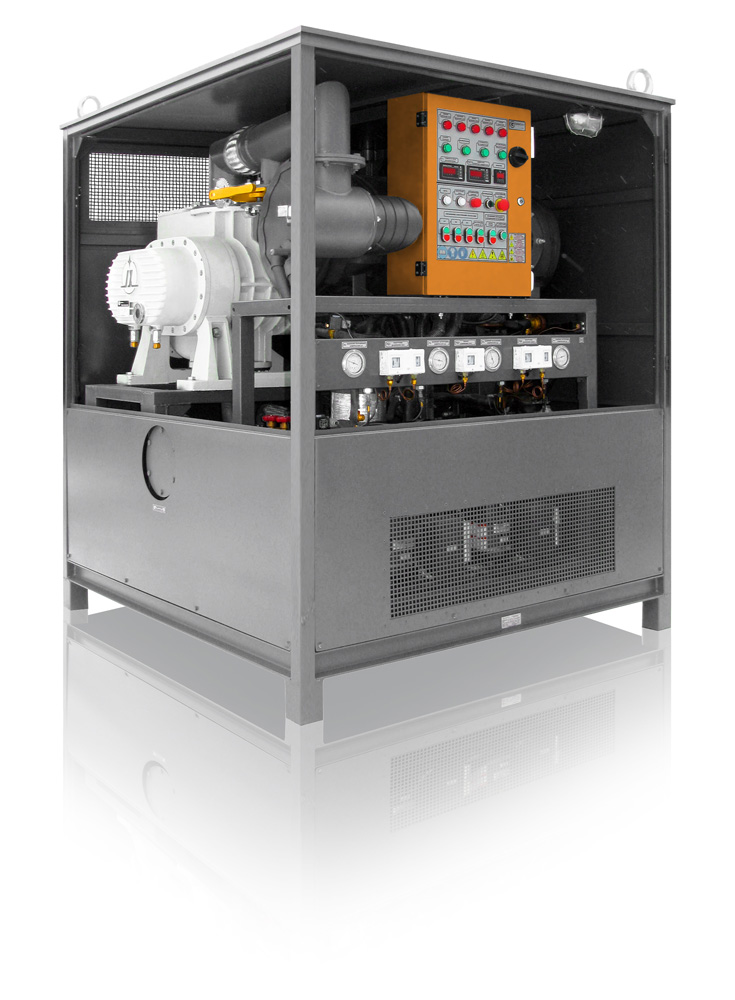Production of new equipment has begun with GlobeCore’s low-temperature refrigeration units. These exciting new units are based on a two (2) stage design and are used for drying the windings inside electric power transformers. The drying takes place during de-pressurization and during service maintenance events.
The machines can reduce working surface temperatures to -70°C/-194°F. The unit is connected to the transformer and a trap via a flexible DU-150 cable. The vacuum system, which vacuums the oil, is connected on the opposite side. When vacuum is created inside the transformer, moisture is turned into vapor. The vapor passes through a low-temperature trap and is frozen on a copper finned surface (copper pipes).
This unit is fully automated and is capable of working non-stop 24 hours per day. These new models have been named the “Frost” because of their ability to significantly lower temperatures. The low-temperature refrigeration unit is actually two units in one. It contains a pre-dilution block, which creates a pre-vacuum in the transformer, and a UVV (vacuum freezing) section. Its function is to create high vacuum inside the transformer.
This newer, more modern GlobeCore model is capable of cooling to -70°C/-194°F and the process is now completely automatic. The only manual step is in connecting the vacuum, cooling unit, and power to the transformer by pressing the “Gathering the Cold” button. The operator is not involved in any part of the automated process once the automated process is started.
The device operates in a mode of extreme cooling (cold gathering) and is capable of dropping the temperature to -70°C/-194°F. The unit can operate in this mode for 6, 8 or 12 hours depending on the chosen setting. There is a viewing window (sight glass) that allows the operator to monitor the amount of accumulated frozen moisture or ice. The operator can periodically check the window, and in case of a large formation of ice, the system can be easily reset to operate in the defrosting mode.
Defrosting is automatic. When the button is pressed, the refrigeration unit stops applying cold and starts to radiate heat to temperatures between +20°C – +30°C/+68°F – +86°F. Depending on the setting, the inner surface is heated and complete thawing of the evaporator will occur. At the rear of the refrigeration unit, there is a valve through which the operator can manually drain the accumulated fluid.
This setting is very useful in determining the degree of humidity inside the transformer. There are similar absorber models in which moisture is absorbed by zeolite. When using the zeolite systems however, determining moisture quantity can be more difficult. In the GlobeCore low-temperature refrigeration units, moisture can be clearly seen during the defrosting process which is a distinct advantage over the zeolite systems.
This machine can work 24 hours a day. The “Cooling Mode” can be set to operate immediately following the defrosting mode. The unit can reach a temperature of -70°C/-194°F within one hour and in defrost mode (up to +30°C/+86°F) it can reach its operating temperature in less than an hour.
The principle behind the operation of the unit:
The system consists of two compressors and two loops for circulating the refrigerant. The first loop is filled with R23 Freon with a boiling point of -82°C. In order to achieve a temperature of -70°C, the end of the evaporator has to be cooled to make the condensation point lower which is approximately -20°C/-4°F. The second loop therefore, acts like a “heat sink” for the first circuit. If you look at the units that operate down to -40°C/-40°F, their capacitors act as the part that cools the refrigerant. The compressor pumps the refrigerant through the system. The refrigerant is condensed in the condenser and is liquefied before entering the DVM. The conversion of the gas to a liquid is achieved due to high pressure at that point in the system. .
Once the Freon’s temperature reaches the boiling point and the liquid turns into a gas, it then radiates out cold. All refrigeration units operate based on this principle which is how heat is transferred. The second loop therefore, serves as the condenser by cooling the refrigerant to a lower temperature.
The unit also contains pressure regulators that protect the unit if the pressure deviates from the desired value. The unit shuts itself down and does not turn on until the proper pressure is restored. The GlobeCore low-temperature refrigeration unit is equipped with manometers that control the pressure in the system.
When the temperature reaches -20°C/-4°F, the second loop is activated. Its ability to cool is due to the heat exchanger that is filled with the R404 Freon. The second Loop cools with R23 Freon and is then fed into the trap. The temperature is gradually lowered until it reaches -70°C. The Unit switches itself off, and then turns back on automatically. This is how moisture is captured from the transformer’s windings.
The low-temperature refrigeration system is highly energy efficient and operates silently. The machine consumes only 6 kW of power during the Defrosting Mode. Total power ranges from 2 to 2.5 kW.

